- All You Need to Know
- Home
- Better health
- Whats potting in the autumn garden
What's potting in the autumn garden?
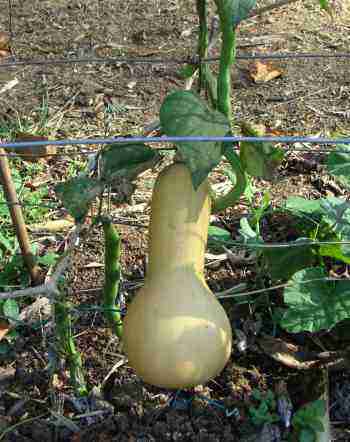
What's potting in the autumn garden is all about harvesting the summer fruits and preparing for winter greens. Organic butternut remain one of my great favourites.
It's the season of mellow fruitfulness; that which ties the end of summer to the winter drought in South Africa. A time of reaping the last of the fruit like green beans and butternut, planting the cool weather vegetables and tidying up masses of twigs and cuttings and heaping all the remains on the compost heaps.
In the planning is a chicken tractor; a small portable run that can be moved every few days providing fresh eggs for the family and manure. First the birds will go on the dead and dying beds of summer vegetables, before the remains go to the compost. Legumes do provide nitrogen but a little extra from the litter won't go amiss. But how will the bees take to fowls scratching not far from the apiary?
It's a busy and most rewarding season; gone is the summer heat that burns the back of your neck and in its place are the cool autumn days characterized by the gentle scent of a thousand flowers borne by the moisture being driven off from their clammy cells; it's driven by the fanning of the bees at the hive entrance as they turn nectar into golden honey for the breakfast table.
All gardeners incidentally should be doing the lower back exercises you'll find in the navigation bar at chiropractic help; the basics take 40 seconds before arising.
Even with the added more advanced core exercises, they will only take you three minutes every morning, before you leap out of bed.
Few have ever captured the sentiments of autumn better than Yeat's immortal poem.
Season of mists and mellow fruitfulness
Close bosom friend of the maturing sun
Conspiring with him how to load and bless
With fruit the vines that round the thatch eaves run;
To bend with apples the moss'd cottage trees,
And fill all fruit with ripeness to the core;
To swell the gourd, and plump the hazel shells
With a sweet kernel; to set budding more,
And still more, later flowers for the bees,
Until they think warm days will never cease,
For summer has o'er brimm'd their clammy cells.
What's potting in the autumn garden?
What's potting in the autumn garden is all about harvesting the summer fruits and preparing for winter greens.
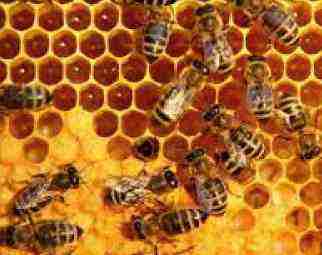
Whether it's the butternut gourds or pole beans, honeycomb or
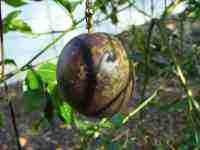
the fruit of the granadadilla vine
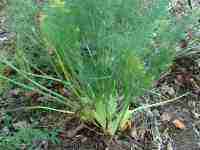
autumn herbs
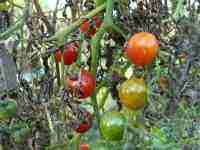
prostate cancer prevention
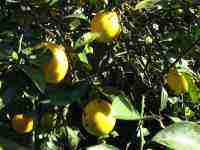
and fruit,
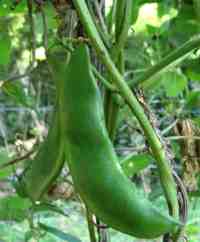
the lima bean and the chili
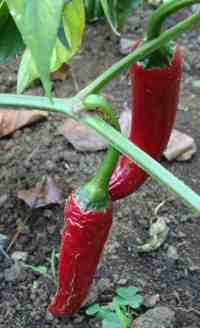
the queen of anti-cancer garden,
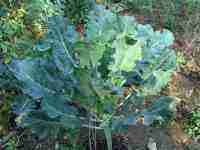
it's the fullness of the maturing sun that you'll find as you contemplate what is potting in the autumn garden. It's my favourite season, neither hot nor cold. A time of reward for all the summer potting and preparation to ensure we have plenty of greens in winter.

Bean seed
Save bean seeds for next spring's planting is one of the priorities; collecting disease free pods; insects too plague the gardener, boring into the seed; each one has to be inspected if one is committed to the organic garden precepts. That means no toxic pesticides.
Having said that, since introducing free range hens to the garden many of the pests like cutworms and the Mexican bean beetle have been dealt with.
As a chiropractor I'm continually faced with the exponential growth of cancer, autoimmune diseases and diabetes in the clinic. Whilst there's no simple answer, I'm convinced that all the chemicals we are faced with on a daily basis is a large part of the cause. We eat and drink them, smear them on our bodies, and breathe them in; many we simply cannot escape but growing your own organic garden, preparing your own natural food and drinking clean water, I'm convinced it will make the difference; yes, it takes time. Either we make that time, or we spend ten times as much visiting the oncologist, rheumatologist and chiropractor; better health is about making the right choices.
Even some of the limas must reluctantly be held back; the green lima seeds are difficult to get and I don't fancy the red striped lima bean; it's too starchy and not nearly as sweet.
Limas are hard work; the growing season is long and podding the shells is time consuming. Still, sufferin succotash takes a lot of beating. Next spring we will plant more.
Healthy choice foods
Healthy choice foods that you can grow in your own garden is what it's all about, and that will be different in your neck of the woods. Do you live in Italy or California? Chiropractic patients would certainly have a couple olive trees.
What's potting in the autumn garden? Firstly it's a time of reaping; the end of summer gourds are waiting to be plucked; the pole and lima beans are still yielding the last of their summer fruitfulness.
Juicy bright red tomatoes and spicy jalapenos add glamour to the daily salad plate and thank the Lord for the lemon trees that bring such beauty to the garden and a piquant flavour to the palate. Whether in the autumn jams or sprinkled over the lunch plate, added to olive pate and hummus, it's the moss'd cottage citrus trees rather than Yeat's apple that adorn our summer rainfall patch.
And there's been a bit of muttering that we've not been planting a row of radish seed for our daily salad every three weeks. I like a bit of a nip in my salad; often one will go into the quick hummus too to spice it up.
Fennel is the new boy on the block; friends have recommended the herb but we have yet to learn how to cook with it. Little fronds in the autumn salad bowl add a lovely different liquorice flavour.
A new curly kale is another experiment for us this year as we try different varieties when potting in the autumn garden; it's subtly different to cabbage and broccoli and provides more diversity. Everything is directed in having as wide a spectrum of foods as we can enjoy.
If you are eating from a narrow band of ingredients, you can be sure you won't be benefiting from the widely diverse phytosterols that are to be found in our foods to prevent cancer and arthritis. They are known in the literature as phytochemicals. Let your food be your medicine.
Fry up half an onion in butter and then add finely chopped kale and a couple tablespoons of water; it's delicious and provides variety to the usual cabbage and broccoli greens. Each have their place.
Broccoli, the queen of the anti cancer foods, we grow in abundance; we particularly like the branching variety that goes on producing florets right through our mild winter. They make the perfect soup enriched with a chicken bones bouillon.
How to grow peas
How to grow peas, and kale too, are high on the greenie's agenda. Neither need huge gardens; it's amazing how much healthy choice food you can reap from your own small patch. What's potting in the autumn garden? It's all very relevant to chiropractic patients wanting stronger bones and smoothly functioning joints.
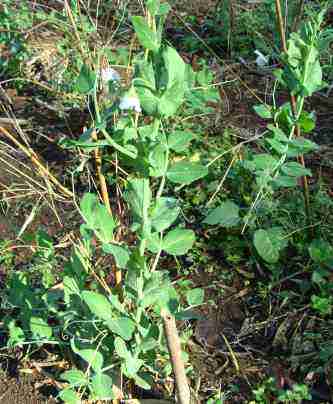
The green pea comes in for a bit of stick from the weight loss fraternity, and to my mind absolutely unjustifiably. Peas have a glycemic index of less than 50 which means they are in the low glycemic category; they certainly don't release a shower of the fat storage hormone insulin. Yes, they do contain some starch and sugars, that's why they are so delicious. Add to that their vegetable protein content, phytonutrients called coumestrol and saponins that lower the incidence of stomach (and presumably other) cancer, and their high fibre content and you have the perfect food. If you're concerned about your weight, garden peas are very low in fat, and that fat is of the highest quality, rich in omega 3 and omega 6 fatty acids.
As an aside, let's consider a few thoughts about fad diets in an increasingly obese world. Take from each what is natural and obviously healthy food and avoid the absurd. If a diet says you must avoid apples because they are high in carbohydrate, or cut out avocados because they are rich in fat, or peas because they have starch, albeit low GI, then just ignore that part. The latest fad, the Banting diet, does have its virtues, but to avoid green peas and apples because they are high in carbohydrate is sheer nonsense to my mind.
I must confess I don't enjoy frozen peas. Think rather about how to grow peas. Turn the sod, plant a row of seeds about one centimetre deep and provide a stake of sorts. Or plant your peas along a fence.
The site that I turn to most frequently for authoritative, research-based information is called the World's Healthiest Foods. Not convinced you should be including green peas in your diet? Just read more about green peas at WHfoods.
Healthy living tips
Healthy living tips is at least half of what this chiropractic site is about. I learned a long time ago, the hard way, when a favourite patient died needlessly, that sparkling good health is a lot more than just having your chiropractic subluxations adjusted. What's potting in the autumn garden in part draws its energy from that revelation.
What's potting in the autumn garden should include half a dozen kale plants; increasingly the nutritional value of kale is being recognised, and she now is threatening to usurp broccoli's crown as queen of the table of cancer preventing foods.
I usually just include a couple fronds when cooking spinach or Swiss chard, or making eggs Florentine. The young leaves are perfect in any organic green salad, deveined and finely chopped.
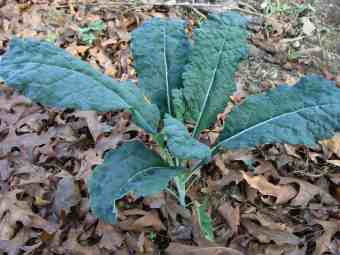
Green peas planted in late summer are now about a foot high and the first flowers are appearing. An early frost will take them but it's worth the chance. Supplementing and reducing animal protein with legumes is high on our agenda.
Whether we think that red meat is bad, even organic red meat, or not is not the point. Many animals providing meat and milk for our diet are now so pumped up with antibiotics and growth hormones, fed fast food diets and now increasingly have never seen a blade of grass; just read Farmageddon.
The only viable alternative for most of us it to eat legumes like chickpeas, pole and lima beans and green peas. Fortunately the latter two are easily grown in the home garden, requiring little attention. Chickpeas for your own hummus is another story; I recommend you use dried peas. They are a third of the cost of canned garbanzo beans.
Notice incidentally the mulch around the curly leafed kale above; it reduces your water consumption considerably and the weeds too. Grown from seed they are looking like a great success in the making. Already the tender young leaves are finding their way into the daily salad.
Something of a nutcase? Sigh, yes possibly that's true. When you've had as much cancer in your family as we have had then we make no apology for being a bit crazy about the delights of the vegetables, salads and fruit, and a healthy diet. And in any case, as some poet once wrote, when the world wearies and society ceases to satisfy, there's always the garden to escape to.
There are few better places to unwind and destress; it's beats taking psychiatric medication hands down.
One of the less pleasant chores in the autumn, once the water level in the reservoir has dropped to below the suction pipe is to empty the tank and clean it out. It holds about five and half thousand gallons, fed from the roof and supplies our whole house and garden.
Harvesting rainwater
Harvesting rainwater is an important part of our backyard permaculture philosophy. It's a vital aid not only to the planet but to what's potting in the autumn garden; it's often a drought period in South Africa.
This year it seems to have an unseen leak, and we have to look at fibreglassing the reservoir. Doing it properly means it hurts only once; I have tried various waterproofing membranes and cements, all to no avail. Yes, it will be costly, if the sealing of our swimming pool is anything to go by, some fifteen years ago by the same company, then I know our reservoir leaks will be over.
People ask about bird droppings and it is a potential problem, one supposes. The alternative is the water supplied in decaying asbestos pipes by the municipality. Interestingly both the good wife and I have had tummy troubles since being forced back to piped water. We can't wait for our reservoir to be repaired and the first spring rains.
Well, the fibreglassing is all done and our rainwater harvesting model is now a great success. It also means you can fill your swimming pool in times of drought when use of municipal water is forbidden, as we are now experiencing in South Africa. Our solar swimming pool is a great success.
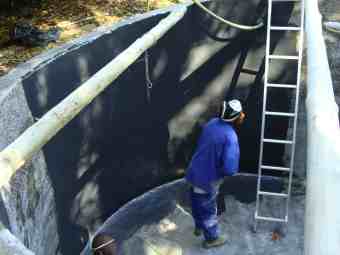
Growing Lemon Trees
Growing lemon trees is so easy; just the scent of the flowers and the beauty of the fruit makes it a worthy decorative plant in any front garden. It's very pretty, very sweet and highly possible to eat!
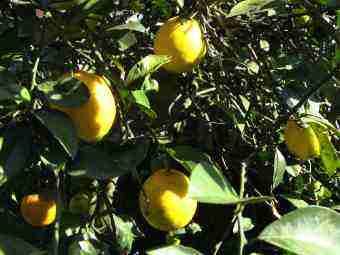
We have a lot of fruit trees in our garden. Ten citrus trees, mulberries, three avocado trees and cherry guavas just to mention a few. All are our favourites in its season but if I had to choose one only, it would be the Meyer lemon; our lime would compete for pride of place.
It flowers twice a year and right now in our whats potting in the autumn garden, it's covered with bright yellow fruit for the second time this season. She who must be obeyed swears it helps the Heberdon's nodes in her fingers (arthritis) as a lemon drink; but on our salads, in the daily hummus and with an orange in my evening drink and in her jams, the lemon is an important part of our diet.
I spoke to an elderly aunt this week about our Meyer lemon; she declared that the first thing she did when moving into a new home was to plant a lemon tree. Whether that's what has enabled her to achieve 87 with all her marbles intact and able to walk five miles twice a week is debatable, but I'm sure it's contributed.
Growing lemon trees is as simple as buying a sapling, digging a hole and planting this core to delicious food tree; water and feed, wait three years and you have the scent and fruit as beautiful as any plant in your garden.
Don't ever purchase concentrated lemon juice, filled with preservatives; it tastes, and is, vile. Just buy half a dozen lemons every week if you live in Chicago or some such place. That's what we learned to do whilst studying chiropractic in that lovely city.
- Growing lemon trees
How to start Beekeeping
How to start beekeeping is a topic requiring considerable aforethought. Mind you, some new Australian hives mean you don't need all the expensive extracting equipment. Just turn a handle and the honey comes pouring out of a pipe from the hive.
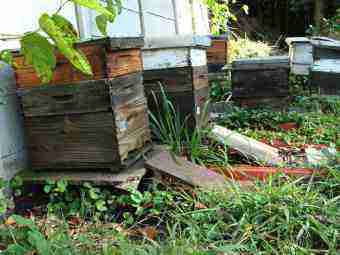
I doubt you could keep bees in Chicago; it's far too cold in the winter months for both lemons and bees; humans too! But here in sunny South Africa we have eight hives in the garden. Right now they are busy with the later eucalypt flowers, and of course all the bee friendly plants in our own patch; the clammy cells are filling fast for the second harvest of the autumn.
Beekeeping is certainly the hobby of my life; it's now more that fifty years since I was given my first hive and still they enthrall and captivate me. Having your own fresh honey, unpasturised and only lightly filtered is a delight that you will never grasp until you taste real raw honey.
Starting beekeeping is not as difficult as you might think. Unless you live in Chicago.
Whether you are looking for information on how to grow peas, or radishes or lemons... whatever, you'll probably find it in this search engine.
Searching for something specific? Just type it in here:
The wonder of worm farms
The wonder of worm farms is how readily these little red guys, called eisenia fetida, process all the waste from your kitchen and garden, turning it into liquid manure and high quality compost.
Becoming a greenie, not quite as nutty as a fruitcake, is a step by step business; Rome wasn't built in a day, nor is the organic green home and garden.
Where to start is an important question; with the simple things of course because you get an immediate encouraging reward.
- Plant a row of radishes, another of green beans, and perhaps half a dozen kale seedlings. A few jalapenos in your front garden bring a riot of colour, and anti inflammatory food to your cooking.
- If you're about to build a new home, then there's a lot to think about. Insulation in the walls and roof, and under the floor, double glazing and a place for a woodstove are all important in my book. You may want to consider provision for harvesting the power of the sun.
- Plant a lemon or lime tree; that's big.
- Now it's time for a compost pile, or a worm farm. Both are important but the worms are easier. Where does the waste go from your garden and kitchen? Make use of it, save yourself trips to the dump and enrich your garden.
- Expand your vegetable and fruit garden. Lettuce and more citrus is where I would start. Enjoying a green salad, sprinkled with fresh lemon juice and olive oil is a daily must in my book.
- A second hand breadmachine would be my next choice; we bake on average about four times a week. It takes less than five minutes.
Chiropractic help
What on earth has all this to do with chiropractic help, you're probably asking? The answer is simple; have your fixated joints adjusted, exercise more and get stuck into what's potting in the garden, and you'll be a different person.
Healthy joints and muscles are utterly dependent on good nutrition and that means learning about obscure subjects like how to grow radishes; they are easiest vegetable to grow and will pep up any green salad.
Growing and cooking green beans fresh from the garden reduces your reliance on red meat for protein; in lemon juice and olive oil, spiced up with a little garlic they are absolutely delicious. The World Health Organisation is unequivocal; better health with chiropractic and medicine means more vegetable protein in our diets.
The humble lettuce is slated everywhere in recipes these days; old greens from the supermarket are indeed very unappetizing, but when growing lettuce is so simple we can be independent for much of the year.
Reducing the inflammation in your joints means in part more beta carotenes and there's no better place to get them than from this organic butternut; they are magnificent right now in our autumn garden, but require a lot of space.
The whole grain, nuts and seeds feature highly in this heart stroke diabetes research.
Doing that, all part of what's potting in the autumn garden would you turn you and your family into serious greenies; preserving our planet for our grandchildren doesn't start at Cop 21 in Paris; it begins in our own homes. The responsibility is ours; it's far too important to leave to fickle, scheming politicians.
Every gardener and certainly beekeeper should be doing these simple exercises every day. In fact if everybody did, it would put a significant number of chiropractors and surgeons out of business! They take less than one minute.
- Home
- Better health
- Whats potting in the autumn garden
Did you find this page useful? Then perhaps forward it to a suffering friend. Better still, Tweet or Face Book it.
